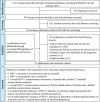Epidemiology of herpes simplex virus type 1 and genital herpes in Australia and New Zealand: systematic review, meta-analyses and meta-regressions
- PMID: 36750224
- PMCID: PMC9990408
- DOI: 10.1017/S0950268823000183
Epidemiology of herpes simplex virus type 1 and genital herpes in Australia and New Zealand: systematic review, meta-analyses and meta-regressions
Abstract
Herpes simplex virus type 1 (HSV-1) infection is a lifelong infection that is acquired primarily orally and during childhood. We aimed to characterise HSV-1 epidemiology in Australia and New Zealand. HSV-1-related data as recent as 6 December 2021 were systematically reviewed, synthesised and reported, following PRISMA guidelines. Pooled mean seroprevalence and proportions of HSV-1 detection in genital ulcer disease (GUD) and in genital herpes were calculated using random-effects meta-analyses. Meta-regressions were also conducted. HSV-1 measures were retrieved from 21 eligible publications. Extracted HSV-1 measures included 13 overall seroprevalence measures (27 stratified) in Australia, four overall proportions of HSV-1 detection in clinically diagnosed GUD (four stratified) in Australia, and ten overall proportions of HSV-1 detection in laboratory-confirmed genital herpes (26 stratified) in Australia and New Zealand. Pooled mean seroprevalence among healthy adults in Australia was 84.8% (95% confidence interval (CI) 74.3-93.1%). Pooled mean seroprevalence was 70.2% (95% CI 47.4-88.7%) among individuals <35 years of age and 86.9% (95% CI 79.3-93.0%) among individuals ≥35 years. Seroprevalence increased by 1.05-fold (95% CI 1.01-1.10) per year. Pooled mean proportion of HSV-1 detection in GUD was 8.2% (95% CI 0.4-22.9%). Pooled mean proportion of HSV-1 detection in genital herpes was 30.5% (95% CI 23.3-38.3%), and was highest in young individuals. Proportion of HSV-1 detection in genital herpes increased by 1.04-fold (95% CI 1.00-1.08) per year. Included studies showed heterogeneity, but 30% of the heterogeneity in seroprevalence and 42% of the heterogeneity in proportion of HSV-1 detection in genital herpes were explained in terms of epidemiological factors. HSV-1 seroprevalence is higher in Australia than in other Western countries. HSV-1 epidemiology in Australia and New Zealand appears to be transitioning towards less oral acquisition in childhood, but more genital acquisition among youth.
Keywords: Australia; New Zealand; genital ulcer disease; herpes; meta-analysis; meta-regression; prevalence.
Figures
Similar articles
-
Epidemiology of herpes simplex virus type 1 in Canada: systematic review, meta-analyses, and meta-regressions.Front Public Health. 2023 Jul 14;11:1118249. doi: 10.3389/fpubh.2023.1118249. eCollection 2023. Front Public Health. 2023. PMID: 37521995 Free PMC article.
-
Herpes simplex virus type 1 in Europe: systematic review, meta-analyses and meta-regressions.BMJ Glob Health. 2020 Jul;5(7):e002388. doi: 10.1136/bmjgh-2020-002388. BMJ Glob Health. 2020. PMID: 32675066 Free PMC article.
-
Epidemiology of Herpes Simplex Virus Type 2 in Canada, Australia, and New Zealand: Systematic Review, Meta-Analyses, and Meta-Regressions.Sex Transm Dis. 2022 Jun 1;49(6):403-413. doi: 10.1097/OLQ.0000000000001612. Epub 2022 Feb 3. Sex Transm Dis. 2022. PMID: 35608096 Free PMC article.
-
The Epidemiology of Herpes Simplex Virus Type 1 in Asia: Systematic Review, Meta-analyses, and Meta-regressions.Clin Infect Dis. 2019 Feb 15;68(5):757-772. doi: 10.1093/cid/ciy562. Clin Infect Dis. 2019. PMID: 30020453 Free PMC article.
-
Serologic Screening for Genital Herpes: An Updated Evidence Report and Systematic Review for the US Preventive Services Task Force.JAMA. 2016 Dec 20;316(23):2531-2543. doi: 10.1001/jama.2016.17138. JAMA. 2016. PMID: 27997660
Cited by
-
MAD-microbial (origin of) Alzheimer's disease hypothesis: from infection and the antimicrobial response to disruption of key copper-based systems.Front Neurosci. 2024 Oct 2;18:1467333. doi: 10.3389/fnins.2024.1467333. eCollection 2024. Front Neurosci. 2024. PMID: 39416952 Free PMC article. Review.
-
Epidemiology of herpes simplex virus type 1 in the United States: Systematic review, meta-analyses, and meta-regressions.iScience. 2024 Aug 5;27(9):110652. doi: 10.1016/j.isci.2024.110652. eCollection 2024 Sep 20. iScience. 2024. PMID: 39224512 Free PMC article.
-
Epidemiology of herpes simplex virus type 1 in Canada: systematic review, meta-analyses, and meta-regressions.Front Public Health. 2023 Jul 14;11:1118249. doi: 10.3389/fpubh.2023.1118249. eCollection 2023. Front Public Health. 2023. PMID: 37521995 Free PMC article.
-
Age-Dependent Assortativeness in Herpes Simplex Virus Type 1 Oral Transmission in the United States: A Mathematical Modeling Analysis.J Infect Dis. 2025 Jul 11;231(6):e1151-e1159. doi: 10.1093/infdis/jiaf157. J Infect Dis. 2025. PMID: 40132653 Free PMC article.
-
Serotype-specific host proteome remodeling in human foreskin fibroblasts during lytic HSV-1 and HSV-2 infection.Virol J. 2025 Jul 14;22(1):239. doi: 10.1186/s12985-025-02803-w. Virol J. 2025. PMID: 40660299 Free PMC article.
References
-
- Fatahzadeh M and Schwartz RA (2007) Human herpes simplex virus infections: epidemiology, pathogenesis, symptomatology, diagnosis, and management. Journal of the American Academy of Dermatology 57, 737–763, quiz 764–736. - PubMed
-
- Brady RC and Bernstein DI (2004) Treatment of herpes simplex virus infections. Antiviral Research 61, 73–81. - PubMed
Publication types
MeSH terms
LinkOut - more resources
Full Text Sources
Medical


